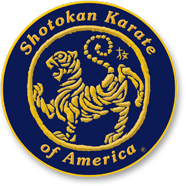Numbers | General | Standing Forms | Blocks | Hand Techniques (punches and other striking techniques) | Kicks | Sparring | Throwing Techniques
For more information on nagewaza, please refer to Karate-Dō Kyōhan, pages 227-232.Numbers
One Two Three Four Five Six Seven Eight Nine Ten General
Head instructor/Master instructor (of an organization) *(see Notes at the end) Instructor *(see Notes at the end) Training hall Training uniform Training uniform belt Vocal expulsion of air Black Belt rank White/Brown belt rank Meditation Bow Assume stance Get ready Begin Pivot/assume opposite direction Stop At ease Basic training Formal exercise/forms Sparring Escape techniques Throwing techniques Foot sweep Maximum effectiveness/ focus of techniques Pulling hand Breathing center in lower abdomen Getting into the opponent Elbow Attacks Jumping-in attack Continuous Techniques Punching board Staff Standing Forms:
Front stance Back stance Horse riding stance Immovable stance Cat stance Natural stance Close-leg stance Half-facing stance Open-leg stance Blocks
Downward block Rising block Forearm block Hammer block Knife-hand block Cross-arm block Two-hand block Palm-heel block Hand Techniques
Lunge punch Reverse punch Jab Continuous punches alternating hands Continuous punching attacks Punching with horse riding stance Double punch Hook punch Palm-heel Rising punch Striking Techniques
Back-fist strike Bottom-fist strike Knife-hand strike Spear-hand Two-finger spear-hand Fore-fist Fore-knuckle fist One-knuckle fist Middle finger/knuckle fist Ridge-hand Kicks
Front kick Round kick Side-thrust kick Side-up kick Crescent kick Stamping kick Rear kick Double front kick Flying front kick Flying side-thrust kick Front kick with front leg Front-thrust kick Continuous kicks Foot edge Heel Kneecap Sparring:
Basic one-time sparring Free one-time sparring Three-time sparring Five-time sparring Free-style Upper body Middle body Lower body Distance, timing, and other things between opponents Match Bow One point match Begin Stop Clash I award no point Continue One more time End of match Half-point Point Two half-points equal one point Draw Red White Red is the winner Referee Throwing Techniques
to topple a folding screen spinning top encircle the neck half wheel 'v' turning swallow to spear a ball to push off a cliff to encircle with the arm to hammer upside down Performer of the technique Receiver of the technique Falling techniques *Notes
When Shihan or Sensei is used as an honorific or a title, there are a few important things one needs to be aware of:
Revised and adapted by Hiroko Mori (September 2004, audio added October 2009, updated to HTML5 Sept 2014)Audio voice recordings by Hiroko Mori. Conversion to MP3 and linkages by John Schoneboom & Mike Lyon.
